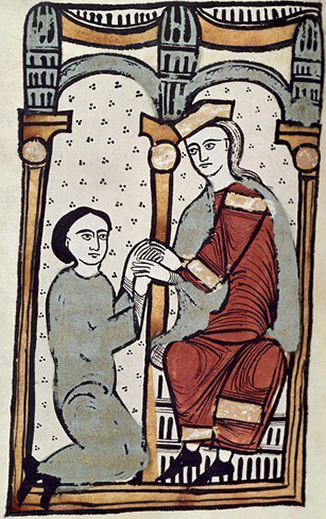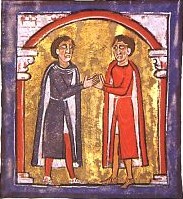|
Ermengol II Of Urgell
Ermengol (or Armengol) II (died 1038), called the Pilgrim, was the Count of Urgell from 1011 to his death. He was the son of Ermengol I, Count of Urgell and one of his wives. He was a child when he succeeded his father and was put under the regency of his uncle Ramon Borrell, Count of Barcelona until 1018. Ermengol went on a pilgrimage to the Holy Land and died in 1038 at Jerusalem. With his uncle's help, Armengol began a successful war of reconquest to the south, taking Montmagastre, Alòs, Malagastre, Rubió, and Artesa. Around 1015, the bishop of Urgell, Armengol, repopulated the region of Guissona. Finally, Arnau Mir de Tost occupied the castle of Àger in 1034. The taifa kings of Lleida and Zaragoza Zaragoza, also known in English as Saragossa,''Encyclopædia Britannica'"Zaragoza (conventional Saragossa)" is the capital city of the Zaragoza Province and of the autonomous community of Aragon, Spain. It lies by the Ebro river and its tributari ... also granted lands ... [...More Info...] [...Related Items...] OR: [Wikipedia] [Google] [Baidu] |
Saint Ermengol
Saint Ermengol (also ''Armengol'' or ''Armengod'') or Hermengaudius (died 1035) was the bishop of Urgell from 1010. Possibly born in the village of Ayguatébia, he was the son of Bernat I, viscount of Conflent, and of his wife Guisla de Lluçià , and also the nephew and successor of Bishop Sal·la and a member of the family of the counts of Conflent.''The Bishop Builds a Bridge: Sanctity and Power in the Medieval Pyrenees'', Jeffrey A. Bowman, The Catholic Historical Review, Vol. 88, No. 1 (Jan., 2002), 1-3. By 1002 Ermengol was an archdeacon and the following year the Bishop of Urgell, Sal·la, had made arrangements for Emermengol to succeed him. He began his episcopate by reforming the cathedral canons, along the lines of the life of Saint Augustine of Hippo, and granting them land in Vallespir, Cerdanya, and Alt Urgell. In 1012, he travelled to Rome for an audience with Pope Benedict VIII,Or possible 1011 for an audience with Sergius IV. who confirmed the possessions of his ... [...More Info...] [...Related Items...] OR: [Wikipedia] [Google] [Baidu] |
11th-century Visigothic People
The 11th century is the period from 1001 ( MI) through 1100 ( MC) in accordance with the Julian calendar, and the 1st century of the 2nd millennium. In the history of Europe, this period is considered the early part of the High Middle Ages. There was, after a brief ascendancy, a sudden decline of Byzantine power and a rise of Norman domination over much of Europe, along with the prominent role in Europe of notably influential popes. Christendom experienced a formal schism in this century which had been developing over previous centuries between the Latin West and Byzantine East, causing a split in its two largest denominations to this day: Roman Catholicism and Eastern Orthodoxy. In Song dynasty China and the classical Islamic world, this century marked the high point for both classical Chinese civilization, science and technology, and classical Islamic science, philosophy, technology and literature. Rival political factions at the Song dynasty court created strife amongst th ... [...More Info...] [...Related Items...] OR: [Wikipedia] [Google] [Baidu] |
11th-century Catalan People
The 11th century is the period from 1001 ( MI) through 1100 ( MC) in accordance with the Julian calendar, and the 1st century of the 2nd millennium. In the history of Europe, this period is considered the early part of the High Middle Ages. There was, after a brief ascendancy, a sudden decline of Byzantine power and a rise of Norman domination over much of Europe, along with the prominent role in Europe of notably influential popes. Christendom experienced a formal schism in this century which had been developing over previous centuries between the Latin West and Byzantine East, causing a split in its two largest denominations to this day: Roman Catholicism and Eastern Orthodoxy. In Song dynasty China and the classical Islamic world, this century marked the high point for both classical Chinese civilization, science and technology, and classical Islamic science, philosophy, technology and literature. Rival political factions at the Song dynasty court created strife amongst th ... [...More Info...] [...Related Items...] OR: [Wikipedia] [Google] [Baidu] |
Count Of Urgell
This is a list of the counts of county of Urgell, Urgell, a Catalan counties, county of the Principality of Catalonia in the 10th through 13th centuries. c. 798–870 Counts appointed by the Carolingians *798–820 Borrell, Count of Osona, Borrell, count of Urgell and county of Cerdanya, Cerdanya *820–824 Aznar GalГndez I, count of county of Aragon, Aragon, was given Borrell's counties while he was exiled from Aragon *824–834 Galindo AznГЎrez I *834–848 Sunifred, Count of Barcelona, Sunifred I *848–870 Solomon, Count of Cerdanya and Urgell, Solomon (or MirГі) 870–992 Counts from the House of List of Aragonese monarchs, Barcelona *870–897 Wilfred the Hairy, Count of Barcelona, Girona-County of Osona, Osona and Urgell-Cerdanya *898–948 Sunifred II, Count of Urgell, Sunifred II *948–966 Miro, Count of Barcelona, MirГі de Barcelona, born c. 940 *966–30 September 992 Borrell II, Count of Barcelona, Borrell II, count of Barcelona, Girona, Osona 992–1213 Counts ... [...More Info...] [...Related Items...] OR: [Wikipedia] [Google] [Baidu] |
Bernard I, Count Of BesalГє
Bernard I ( 977 – 1020), called Taillefer (''Bernat Tallaferro''), was the Count of Besalú in Catalonia from 988 until his death. He was the eldest son of Oliba Cabreta and Ermengard of Empúries, and succeeded his father in Besalú while his younger brothers Oliba and Wifred, inherited Berga–Ripoll and Cerdagne–Conflent, respectively. He was the great-grandson of Wilfred the Hairy, and therefore belonged to the House of Barcelona. Youth and succession Bernard's first public action took place during the reign of his father, when he witnessed, alongside his mother, the donation of the church of Saint Vincent by Miro II to the church of Besalú on 12 April 977. According to the surviving charter, ''Miro ... comes atque episcopus'' (Miro ... count and bishop) granted ''ecclesiam sancti Vincentii'' (the church of Saint Vincent) to ''ecclesiæ Bisuldunensi'' (the church of Besalú) with the consent of ''Ermengardæ comitissæ et filio eis Bernardo'' (Countess Ermengard and ... [...More Info...] [...Related Items...] OR: [Wikipedia] [Google] [Baidu] |
Ermengol III, Count Of Urgell
Ermengol (or Armengol) III (10321065), called ''el de Barbastro'', was the count of Urgell from 1038 to his death. He was the son of Ermengol II, Count of Urgell and his wife Velasquita "Constance", probably the daughter of Bernard I, Count of BesalГє. Life Allied with his contemporary and second cousin Ramon Berenguer I, Count of Barcelona, together they shared in the process of erosion of the comital authority to the noblesse. They also cooperated in the ''Reconquista'' and he received a third part of the conquests, occupying, in 1050, Camarasa and Cubells after taking them from Yusuf of Lleida. In 10391040, Ermengol and Raymond Berengar signed a pact against Raymond of Cerdanya. Later in that decade, Raymond Berenger paid 20,000 ''solidi'' for Ermengol's support and military aid. He took part in the Barbastro War of 1064 under the banner of his brother-in-law Sancho RamГrez of Aragon. When Barbastro was captured, he was given the lordship of the city. He died before 12 Apr ... [...More Info...] [...Related Items...] OR: [Wikipedia] [Google] [Baidu] |
Taifa Of Zaragoza
The taifa of Zaragoza () was an independent Arab Muslim state in the east of Al-Andalus (present day Spain), which was established in 1018 as one of the taifa kingdoms, with its capital in Saraqusta (Zaragoza) city. Zaragoza's taifa emerged in the 11th century following the destruction of the Caliphate of Córdoba in the Moorish controlled Iberian Peninsula. During the first three decades of this period (1018–1038), the city was ruled by the Arab Banu Tujib tribe. They were replaced by the Arab Banu Hud rulers, who had to deal with a complicated alliance with El Cid of Valencia and his Castilian masters against the Almoravids, who managed to bring the Taifas Emirates under their control. After the death of El Cid, his kingdom was conquered by the Almoravids, and by 1100 they had crossed the Ebro into Barbastro, which brought them into direct confrontation with Aragon. The Banu Hud stubbornly resisted the Almoravid dynasty and ruled until they were eventually defeated by the ... [...More Info...] [...Related Items...] OR: [Wikipedia] [Google] [Baidu] |
Kingdom Of Lleida
Kingdom commonly refers to: * A monarchy ruled by a king or queen * Kingdom (biology), a category in biological taxonomy Kingdom may also refer to: Arts and media Television * ''Kingdom'' (British TV series), a 2007 British television drama starring Stephen Fry * ''Kingdom'' (American TV series), a 2014 US television drama starring Frank Grillo * ''Kingdom'' (South Korean TV series), a 2019 South Korean television series *'' Kingdom: Legendary War'', a 2021 South Korean television series Music * Kingdom (group), a South Korean boy group * ''Kingdom'' (Koda Kumi album), 2008 * ''Kingdom'' (Bilal Hassani album), 2019 * ''Kingdom'' (Covenant Worship album), 2014 * ''Kingdoms'' (Life in Your Way album), 2011 * ''Kingdoms'' (Broadway album), 2009 * ''Kingdom'' (EP), a 1998 EP by Vader * "Kingdom" (Dave Gahan song), 2007 * "Kingdom" (Maverick City Music and Kirk Franklin song), 2022 * "Kingdom", a song by Battle Beast on their 2013 album '' Battle Beast'' * "Kingdom", a so ... [...More Info...] [...Related Items...] OR: [Wikipedia] [Google] [Baidu] |
Taifa
The ''taifas'' (singular ''taifa'', from ar, Ш·Ш§Ш¦ЩЃШ© ''б№ДЃ'ifa'', plural Ш·Щ€Ш§Ш¦ЩЃ ''б№awДЃ'if'', a party, band or faction) were the independent Muslim principalities and kingdoms of the Iberian Peninsula (modern Portugal and Spain), referred to by Muslims as al-Andalus, that emerged from the decline and fall of the Umayyad dynasty, Umayyad Caliphate of CГіrdoba between 1009 and 1031. They were a recurring feature of al-Andalus history. The ''taifas'' were eventually incorporated by the Almoravid dynasty in the late 11th century and, on its collapse, many ''taifas'' re-appeared only to be incorporated by the Almohad Caliphate. The fall of the Almohads resulted in a flourishing of the ''taifas'', and this was the case despite constant warfare with Christian kingdoms. Taifa kings were wary of calling themselves “kings,” so they took the title of ''hajib'', presenting themselves as representatives for a temporarily absent caliph. The ''taifa'' courts were renowned centr ... [...More Info...] [...Related Items...] OR: [Wikipedia] [Google] [Baidu] |
ГЂger
Àger is a municipality in the ''comarca'' of the Noguera in Catalonia, Spain. It is situated in the north-west of the ''comarca'', and the territory of the municipality stretches between the Noguera Ribagorçana and Noguera Pallaresa rivers. The Terradets reservoir on the Noguera Pallaresa is situated within the municipality. The village is linked to Balaguer and Tremp by the L-904 road. Villages *Àger town, 317 inhabitants. *Agulló, 45 inhabitants. *Corçà , 32 inhabitants. * Fontdepou, 16 inhabitants. * Els Masos de Millà , 17 inhabitants. * Millà , 5 inhabitants. * La Règola, 21 inhabitants. * Sant Josep de Fontdepou, 19 inhabitants. *Vilamajor, 13 inhabitants. See also *Viscounty of Àger * ''Apostles from Àger'' *Montsec The Montsec Range ( ca, Serra del Montsec ; es, Sierra del Montsec) is a mountain system of the Pre-Pyrenees. Description The Serra del Montsec consists of a series of calcareous mountain ranges running roughly from east to west. The range syste .. ... [...More Info...] [...Related Items...] OR: [Wikipedia] [Google] [Baidu] |





